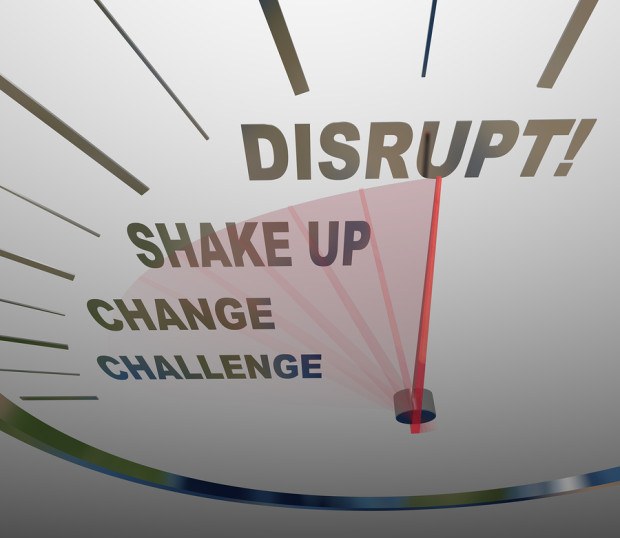Much has been written about innovation in the insurance industry as well as Google’s Compare, USAA’s recent participation in Compare, Liberty Mutual’s venture with Nest, big data, etc.
Executive Summary
Companies whose core businesses had to do with taking pictures, booking travel, selling books and music—along with a host of others—have been upended by technology companies that found new ways of doing those same activities. Erin Hamrick of Sterling James provides a comprehensive “gone list” and suggests that the handwriting is on the wall for insurers that don’t reshape their businesses with a focus on technology at the core.What is really happening here?
It’s simple. The elephant in the room is the rapid pace of technology as the core disrupter that will change the industry forever.
The insurance industry looks to the past in order to predict the cost of insuring the future. The irony is that if we assess the constructive disruption that has happened in the past in virtually every industry except ours, then shouldn’t we be better prepared for technology to gobble us up? Let me explain.
As for the financial services industry, it “has been visibly transformed by software over the last 30 years. Practically every financial transaction, from someone buying a cup of coffee to someone trading a trillion dollars of credit default derivatives, is done in software,” he wrote.
Remember Pac-Man as he went through all those mazes eating up everything in his path? Keep that mental picture and think about Marc Andreessen’s Wall Street Journal essay written four years ago, “Why Software Is Eating The World” (WSJ, Aug. 20, 2011).In it, he explained how the world was changing because every industry is being defined by sophisticated software. (See accompanying textbox for more on Andreessen and his essay.)
In reality, technology is at the core of every industry where there has been some form of constructive disruption. If leaders in the insurance industry do not believe that each of their organizations needs to be a technology company at its core, while also providing financial protection/risk management/insurance “activity” to their customers, then there is no need to read further. You’ll be going the way of the companies and industries listed below—just like Kodak.
Kodak, which created the first digital camera, went bankrupt anyway. This is still shocking to me. Much has been written about this but, quite simply, Kodak forgot that it was in the “taking pictures” business. Taking pictures is an “activity.” Kodak forgot because it was beholden to the money it made selling film and to everything associated with selling film. (Editor’s Note: Steven Sasson, an electrical engineer, is credited with building the first digital camera prototype at Eastman Kodak in 1975.)
How much did the first digital camera cost to make? A lot. And this invention required even more investment to perfect—a lot more. How much is “a lot?” I can only assume it’s more than going bankrupt.
Was there debate at the board and management team level on disrupting their distribution? Probably a good deal of it.
Hmmm… Lots of money is made in this insurance continuum of ours too. Remember this Kodak example when we review what I call “The Gone List” below and the associated “activity” that still remains.
The Gone List
- Photography stores: gone.
But we still take photos. We use phones.
- Travel agencies and airline agents: gone.
But we still travel. We use online providers like TripAdvisor, Expedia, Kayak, Priceline or book direct.
- Book stores: gone.
But we still read books thanks to Amazon’s Kindle and other e-readers.
- Music stores: gone.
But we still listen to music. As an aside, Steve Jobs bought SoundJam MP around the turn of the century and renamed it iTunes. Music stores became obsolete. Fifteen years later, music streaming services like Pandora and Spotify are now taking over the music market, paving the way for Apple’s announcement that it would purchase Beats last year.
- Real estate firms: almost gone.
But we still are buying homes. Zillow competed against Trulia until it purchased the company in a deal closed in February 2015. How many online inventories of real estate do you need that show buying history, taxes and comps?
- TV/movies/cable/Internet service providers: Some would argue that TV is gone. The reality is that in this segment it is all blurring into one. Why?
We still want to be entertained. It is the delivery of the “activity” that has changed.
A related note about Netflix: In 2011, Netflix’s CEO announced the division of the business into online streaming and old-fashioned DVD. The stock plummeted 25 percent on the announcement. In 2012, Netflix had 27.1 million streaming customers; in 2013, 40 million streaming customers; and by 2014, Netflix was streaming to nearly 60 million customers, according to company reports. Currently, Netflix streams to more than 62 million members in more than 50 countries, according to Netflix’s website.
And Netflix now produces its own content, such as “House of Cards.” Type the query “How Netflix Uses Analytics to Select Movies and Create Content” or something similar, and you’ll find thousands of articles about how Netflix used data analytics to develop “House of Cards.” (See for example, “Netflix’s House of Cards and Other Big Data Case Studies,” at carriermag.com/fq27z.)
- Newspapers: gone.
But we still read the news, just online.
- Big box retail: gone.
But we still buy appliances, furniture and dog/cat food. If you have animals or use anything on a monthly basis and haven’t signed up for Amazon’s subscription service, check it out.
- Paper money: almost gone.
But we still make purchases. Now there is Bitcoin, Apple and Google Wallet.
- Stock brokers/exchange floor traders: gone.
But stocks are still bought and sold.
- Taxi services: going quickly.
But we still need hired cars. Uber, which owns no taxis, has created a whole uberization movement that expands beyond ground transportation. Need a flight on a private plane at the last minute? There are Uber-style apps for that.
Finally, consider Tesla, a computer on wheels. If you haven’t ridden in one, you should. You’ll really get what is going on here.
The list could go on, but let’s move back to insurance.
Have you heard of MetroMile? Here’s how the company describes itself: “We connect your smartcar to your smartphone. Our smart driving tools help you do everything from find where you parked, to monitor your car’s health, to give you access to our certified mechanic.”
What does MetroMile really do? It sells insurance by the mile. (Editor’s Note: MetroMile is a managing general agency. Its insurance products are written by insurers in the National General Insurance Group.)
The chairman of MetroMile is David Friedberg, a former Google engineer who created WeatherBill in 2006. The company changed its name from WeatherBill to The Climate Corporation in 2011. What did Climate Corp. do initially? Sell weather insurance to ski companies. In 2010, it moved to focus on agriculture exclusively and became approved by the USDA to sell crop insurance. In 2013, it sold to Monsanto for nearly $1 billion. How long did all of that take? Four years. When did Marc Andreessen pen his article? Four years ago. (Editor’s Note: Like MetroMile, Climate Corp. operates as a managing general agency, with crop and hail multiperil insurance policies currently being written by OneBeacon Insurance Group.)
Here is the sobering truth: “Software is eating the world.” Systematically, like Pac-Man, software is going through industry by industry, gobbling up everything in its path.
As an industry, insurers do not realize how fortunate we are to see that Pac-Man is close but hasn’t descended upon us just yet. We still have time to create a strategy before we are overtaken by those actively looking to gobble us up.
Financial protection/risk management/insurance is an “activity” the world will always need. But for every other industry/company on “The Gone List,” the technology companies came in and said, “I can build that core ‘activity’ electronically and put them out of business.” This is constructive disruption at work.
How the financial protection/risk management/insurance activities across the insurance continuum are going to be defined electronically is ours for the defining. This is not an if scenario; it is when and it is soon. We are in Pac-Man’s path.
How much will it cost to define and build a technology company? A lot. And how much is a lot? I don’t know, but I do know the cost of doing nothing. Reread the list. The historical data is there to predict the cost of our industry’s future.
Google and others are the Pac-Mans. They are moving quickly, and we are in their sights. We can stand still and wait to be gobbled and added to “The Gone List.” Or we can begin to think in terms of transforming into technology companies.





















 Executive Utterances: On Presenting
Executive Utterances: On Presenting  Water Leaks, Frozen Pipes Top List of Small Business Claims: The Hartford
Water Leaks, Frozen Pipes Top List of Small Business Claims: The Hartford  Rebuilding Negotiation Talent: Why This Skill Is Missing and How to Fix It
Rebuilding Negotiation Talent: Why This Skill Is Missing and How to Fix It  ‘Dream Is in Sight:’ Chamber, Reinsurers, Insurers Urge Florida to Stay the Course
‘Dream Is in Sight:’ Chamber, Reinsurers, Insurers Urge Florida to Stay the Course 











